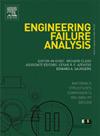Limitations of GFRP wrapping revealed by Erosion–Corrosion and sulfide stress cracking in Sour-Gas Environments: Experimental and numerical simulation perspectives
IF 5.7
2区 工程技术
Q1 ENGINEERING, MECHANICAL
引用次数: 0
Abstract
This study examines the failure of a U-shaped heat exchanger outlet pipe internally wrapped with eight layers of glass fiber reinforced polymer (GFRP), which leaked after only four months of operation at 120–140 °C. A multi-approach investigation was conducted through visual, metallurgical, mechanical, and computational fluid dynamics (CFD) analyses. Visual inspection identified deposit buildup that caused turbulent multiphase flow and wall thinning to below 1 mm, producing high hoop stress and rupture. Metallurgical analysis revealed intergranular corrosion and cracking. Based on Scanning Electron Microscope-Energy Dispersive X-ray (SEM-EDX) observation results from three observation locations, the failure location and Heat Affected Zone (HAZ) have the highest sulfur content, approximately 1.6 at% and 2.18 at%. This data reveals that the pipe absorbed H2S gas, and the presence of sulfur allows for sulfide stress corrosion cracking (SSCC). Additionally, SEM-EDX results from all three locations also showed the presence of chlorine (Cl), which can lead to pitting corrosion. Fourier-Transform Infrared spectroscopy (FTIR) spectra showed acidic compounds such as amine salts, carboxylic acids, and anhydrides, indicating corrosion–deposit interaction. Mechanical tests demonstrated hardness in the weld area of 212–245 HV compared to < 180 HV in the base metal, indicating higher brittleness. Tensile strength reached 444.2 MPa in the HAZ, 437.2 MPa in the weld, and 407.3 MPa in the base metal. Compression strength decreased from 294.15 MPa (base metal) to 268.81 MPa (HAZ). Flexural resistance declined by 30 % near the leakage (2.55 kN vs. 8.49 kN for new GFRP). Impact energy absorption also dropped from 79 J (base metal) to 55 J (HAZ), marking a ductile-to-brittle transition. CFD confirmed turbulent flow and high wall shear at the sockolet, intensifying erosion–corrosion synergy. These results demonstrate the combined effects of SSCC, deposit-induced erosion, and turbulent flow as primary causes of failure. The findings highlight the limitations of GFRP wrapping in sour-gas environments and point toward future applications of high temperature adhesive, flow-conditioning design, and CFD-based predictive maintenance to extend service life in pipelines and refinery heat exchangers.
GFRP包覆在酸性气体环境中的侵蚀腐蚀和硫化物应力开裂的局限性:实验和数值模拟的观点
本研究考察了u型热交换器出口管道内部包裹8层玻璃纤维增强聚合物(GFRP)的故障,该管道在120-140°C下运行仅4个月后泄漏。通过视觉、冶金、机械和计算流体动力学(CFD)分析进行了多方法调查。目视检查发现,沉积物堆积导致了湍流多相流动,管壁变薄至1毫米以下,产生了高环向应力和破裂。金相分析显示晶间腐蚀和开裂。基于三个观测位置的扫描电子显微镜-能量色散x射线(SEM-EDX)观测结果,失效位置和热影响区(HAZ)的硫含量最高,分别为1.6 at%和2.18 at%。这些数据表明,管道吸收了H2S气体,硫的存在导致了硫化物应力腐蚀开裂(SSCC)。此外,三个位置的SEM-EDX结果也显示氯(Cl)的存在,这可能导致点蚀。傅里叶变换红外光谱(FTIR)显示出酸性化合物,如胺盐、羧酸和酸酐,表明腐蚀-沉积相互作用。机械测试表明,焊缝区的硬度为212-245 HV,而母材的硬度为180 HV,表明脆性更高。热影响区抗拉强度为444.2 MPa,焊缝抗拉强度为437.2 MPa,母材抗拉强度为407.3 MPa。抗压强度由294.15 MPa(母材)降至268.81 MPa(热影响区)。在泄漏附近,弯曲阻力下降了30% (2.55 kN vs.新GFRP为8.49 kN)。冲击能量吸收也从79 J(贱金属)下降到55 J(热影响区),标志着韧性到脆性的转变。CFD证实了套筒处的湍流流动和高壁面剪切,增强了侵蚀-腐蚀协同作用。这些结果表明,SSCC、沉积物侵蚀和湍流的综合作用是破坏的主要原因。研究结果强调了GFRP包装在含酸气体环境中的局限性,并指出了高温粘合剂、流量调节设计和基于cfd的预测性维护的未来应用,以延长管道和炼油厂热交换器的使用寿命。
本文章由计算机程序翻译,如有差异,请以英文原文为准。
求助全文
约1分钟内获得全文
求助全文
来源期刊

Engineering Failure Analysis
工程技术-材料科学:表征与测试
CiteScore
7.70
自引率
20.00%
发文量
956
审稿时长
47 days
期刊介绍:
Engineering Failure Analysis publishes research papers describing the analysis of engineering failures and related studies.
Papers relating to the structure, properties and behaviour of engineering materials are encouraged, particularly those which also involve the detailed application of materials parameters to problems in engineering structures, components and design. In addition to the area of materials engineering, the interacting fields of mechanical, manufacturing, aeronautical, civil, chemical, corrosion and design engineering are considered relevant. Activity should be directed at analysing engineering failures and carrying out research to help reduce the incidences of failures and to extend the operating horizons of engineering materials.
Emphasis is placed on the mechanical properties of materials and their behaviour when influenced by structure, process and environment. Metallic, polymeric, ceramic and natural materials are all included and the application of these materials to real engineering situations should be emphasised. The use of a case-study based approach is also encouraged.
Engineering Failure Analysis provides essential reference material and critical feedback into the design process thereby contributing to the prevention of engineering failures in the future. All submissions will be subject to peer review from leading experts in the field.
 求助内容:
求助内容: 应助结果提醒方式:
应助结果提醒方式:


